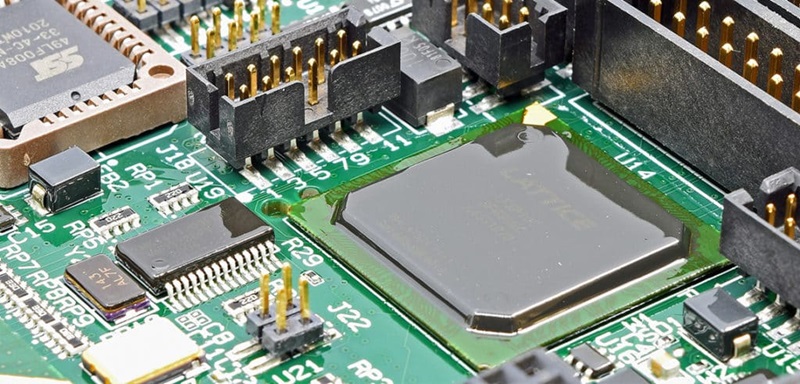Conformal coatings protect electronic circuits from harsh environments by forming thin, chemical films that conform to the circuit board's topography. These coatings protect against moisture, chemicals, contamination, vibration, corrosion, and thermal stress, while also improving product reliability by reducing failures. The benefits that conformal coatings can provide often vary by industry. For aerospace conformal coatings, protection against corrosive gases, outgassing, tin whiskers, and radiation is a primary emphasis.

aerospace conformal coating
What is conformal coating?
Conformal coatings are specialized polymer film-forming products that protect circuit boards, components, and other electronic devices from harsh environmental conditions. These coatings conform to the inherent irregularities of the PCB structure and the environment. They improve dielectric resistance, operational integrity, and protect against corrosive environments, moisture, heat, fungus, and airborne contaminants such as dust and dirt.
Aerspace equipment is often exposed to harsh conditions such as high temperatures (up to +125°C), extremely low temperatures (approximately –55°C), severe vibration, salt spray corrosion, and vacuum environments. Therefore, aerospace conformal coatings play a key protective role in critical systems (avionics, navigation, and communication modules).
Common Coating Types in Aerospace
In aerospace electronics, choosing the right type of aerospace conformal coating is crucial. The properties of different materials significantly impact reliability, processing efficiency, and environmental compatibility. Below is a brief comparison of several common types:
1. Acrylic: Inexpensive, easy to apply and rework, and offers good electrical insulation and moisture resistance. However, it has poor solvent resistance and is suitable for avionics applications where chemical exposure is less critical.
2. Silicone: Suitable for extreme temperature environments, with excellent moisture and salt spray resistance, it is the preferred choice for many critical aerospace conformal coating projects. However, it has poor abrasion resistance and average thermal aging performance.
3. Polyurethane: It offers excellent adhesion, corrosion resistance, and thermal conductivity, making it suitable for high-humidity or mechanically complex environments. However, its long cure cycle makes rework difficult.
4. Epoxy: High strength and excellent solvent resistance make it suitable for avionics circuit protection in harsh industrial conditions. However, its high rigidity makes it susceptible to cracking due to stress concentration.
6. Parylene (polyparaxylene): Provides excellent electrical properties and a uniform, ultra-thin protective layer for high-end aerospace conformal coatings. It is suitable for high-frequency or microelectronic systems, but has high equipment requirements and high costs.
Challenges Facing Aerospace Applications
With the rapid growth of the aerospace industry, new demands are constantly emerging, and architectural and tourism projects are facing new challenges. Key issues include:
1. Complexity. Aerospace travel is more complex than ever, and the components configured and manufactured for it are equally complex. Projects demand greater effort, faster throughput, and more reliable results, and some coating methods simply cannot meet this demand.
2. Bubbles. One of the biggest challenges in aerospace conformal coating applications is the potential for bubbles, which can disrupt functionality or even cause circuit failure.
3. Protection. Individual parts and electronic components must be completely protected from the extreme environment of space. Some conformal coatings fail to provide this protection, leaving pinholes or uneven coverage, especially on multi-layered objects or surfaces with unusual shapes and gaps.
3. Risk. In aerospace, the stakes are extremely high. Even a minor malfunction can be life-threatening, and damage to a single component can mean millions, or even billions, of dollars in repair costs.
Luckily, there is an answer to all of these issues and more: Parylene. Parylene stands alone in aerospace conformal coatings. Its vacuum deposition process, pinhole-free coverage, and unmatched chemical properties make it an exceptionally reliable choice even in extreme conditions and environments.
Here are just a few of the ways it's particularly valuable in aerospace applications:
-Ultra-thin, smooth, and truly conformal.
-Optically clear.
-Controllable thickness.
-Chemically inert.
-Tolerant to thermal expansion mismatches.
-Resistant to chemicals, solvents, fuels, moisture, gases, fumes, corrosion, and harsh environmental conditions.
-No stress or lengthy cure cycles—ready for immediate use.
-Hydrophobic—repels water.
-Compliant with NASA-STD-8739.
Summary
Conformal coatings are the final protective barrier for aerospace electronics. Choosing the right aerospace conformal coating, aligning with industry standards, and implementing an effective coating strategy are essential to ensure both long-term reliability and manufacturing efficiency. If you're working on avionics design or production, feel free to contact us for technical guidance, sample testing, or a free project evaluation.